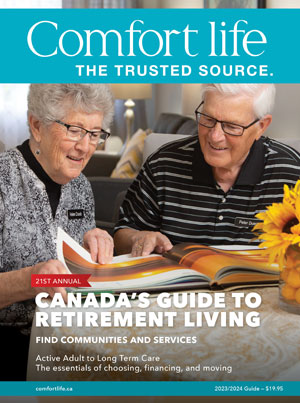In the COVID-19 pandemic, the senior care home industry endured untold harm to its popular perception. While infections and deaths happened everywhere, though, many retirement homes on Comfort Life kept safety, health and security of seniors as their highest priority. Here, we remind you of the advantages offered under any circumstances.
Social isolation measures instituted around the world negatively impacted all of us. Life wasn't much different for people living in independent or assisted living than for anyone else. In many respects, the lives of seniors in retirement communities remained better than alternatives like living in an outdated family home, or in apartment buildings or condos, where they're surrounded by people with whom they share little in common. And where they were even more susceptible to infection. Below, we look at both the benefits of senior living, and remind people of significant differences between retirement homes and long-term care.
Retirement homes: still the best place to be
Because retirement homes are privately funded and run, they offer advantages over any alternative way of living. Here's a look at all the benefits offered in Canada's finest retirement communities.
Staff and support
Many seniors move into a retirement home as a way of keeping their independence. Housekeeping and meal preparation are all handled by others. This removes many potentially harmful situations for them. What’s more, personal health crises can be easily averted, since care staff is on hand. People are not alone if they have a sudden health crisis, where any problem is dealt with immediately and professionally and given the proper, immediate medical attention.
Cleanliness and disinfection
Disinfecting and cleaning surfaces alone in your own home can be challenging, and disinfection is a key to keeping viruses from spreading. Retirement homes work under outbreak protocols. They vigilantly clean and disinfect suites and common spaces and institute other measures that go above and beyond government directives. The availability of staff hired to do these tasks and perform them professionally makes retirement homes safer than many people’s houses.
Unique accessibility and safety
Further to discussions above, fall risks and other household injury risks (for example burns while cooking, etc.) are no longer a threat to anyone living in a retirement home. They no longer need to go up and down stairs, carrying a laundry basket and heavy cleaning supplies. People like Reg, at Credit River in Mississauga, are still happy, living in a place where stairs are a thing of the past, and his bad knees are no bother.
Healthy corrective to social isolation
Social isolation measures during the pandemic exacerbated the unhealthy loneliness of seniors who choose to live on their own. Seniors in retirement homes always have “friends just outside the door” whom they can call and speak with, giving each other sympathy and moral support, even as they faced the same challenges of self-isolating we all did. Staff are also part of their social circle. In a community, seniors still make many daily connections and have friendly, fulfilling interactions with those around them. There are still celebrations and other events.
Separation from the outside world reduces exposure
Seniors in a retirement home actually benefit from some reduced exposure to risk, because they never need to go out. Public places are where the risk of community transmission of viruses like COVID-19 and its variants is highest. In many retirement homes, all the amenities within the community provide all the daily entertainment needed. Food is shipped into the home and handled by staff who follow strict sanitary protocols. Fitness and entertainment opportunities in-house fill seniors’ days as well or better than they do for anyone living anywhere else.
Long-term care vs. retirement homes
Especially during the first months of the COVID-19 crisis, Canadians’ attention was drawn to long-term care (LTC) homes, where a significant percentage of fatalities occurred. Unfortunately, many people still consider long-term care synonymous with retirement homes. There are significant differences between the two. For those considering a move or care, here’s an abbreviated look at how long-term care (aka nursing homes) is markedly different from retirement living.
Health vulnerability
In long term care, people are naturally more vulnerable. They are there because of weakened health or suffering from disorders that make them more vulnerable to COVID-19 and other infections. Many are cognitively impaired and cannot identify their symptoms, so they have been unable to protect themselves. Writing in the National Post, Randall Denley proposes, a “more accurate term for long-term care would be end-of-life care.”
In contrast, seniors move into independent living and even assisted living simply because it is better than being on their own. People move into independent living (often with minimal health problems) to live amongst peers or as part of a couple where only one needs assistance. In assisted living, most seniors need help with only one or two activities of daily living (such as bathing or feeding) and are otherwise healthy and independent.
Placement vs. choice
Long-term-care is administered by provincial governments across the country. Seniors meet assessment requirements set by the province, and are then placed into long-term care on a first-come, first-served basis, based on an urgent need for immediate help. Most often, there are waiting lists to get into these facilities. In addition, there’s noteworthy variation in the quality of facilities, such as age of the building, number of people per suite, staff-to-resident, and more. One anonymous senior care administrator admits, “It’s just how it is. Not all long-term care homes are the same.”
Desirable options are limited. Consequently, families delay a move, because they want their loved one in a facility most to their liking. They will put themselves on a waiting list, specific to a long-term care home they want for their loved one, as seen in the province of Ontario.
In contrast, retirement homes are populated by those who choose to be there. Seniors in independent living like the fact that they don’t have to do any more housekeeping, cooking, and dishes. They stay for the communal lifestyle. This is more appreciated over time, and many are surprised at how much more joyful life is, in community than when they were living on their own.
Number of people per room
In long-term care homes, private suites are seldom available. Where they are, families pay more for private suites as they become open, although availability of private suites is always limited.
In retirement homes, people pay for a suite, where they live alone or as a couple. As such, suites have the same privacy as any apartment. Residents can choose to stay in their suite as much as they deem necessary, under normal circumstances. The communities themselves tend to be more spacious, and up-to-date in construction standards.
Great differences in common space
The issue of overcrowding in long-term care extends to shared or common space, such as hallways and corridors. Many long-term care homes were built in decades past, when accessibility design had not yet progressed to where it is now. Consequently, long-term care homes tend to have narrower passageways of eight feet wide or less. In this situation, keeping social distance from those you pass in the hallway is plainly difficult.
Common areas in many retirement homes on ComfortLife.ca offer much more room. Many retirement homes feature an array of common areas that may include several lounges, a pub, a bistro, and more.
Contact with care staff
Seniors in long-term care require contact with care staff, of course. Personal support workers do an incredible job, and in the pandemic, these workers were very vulnerable. However, the fact is that they often worked part-time in care communities, and many had to hold down more than one job to make ends meet. The rules around this changed since the initial outbreak, but in the first few months of the crisis, community transfer by multi-location workers was isolated as a contributing factor to high mortality rates in long-term care communities.
Many residents in independent living retirement homes will have little need for contact with care staff or other staff. Under normal circumstances, people will be friendly with anyone within the community, of course. In assisted living, they will need to work with care workers, of course.
Staff-to-resident ratios
Subject to limited operational budgets, many long-term care facilities have less staff, with more people crowded into the facility.
Staffing levels are often notably higher in retirement homes. The staff-to-resident ratio is likely to be much more favourable in assisted living and memory care in a private retirement home.
Sources and further reading
"The truth about long-term care outbreaks isn't really about 'greedy' owners and mistreated staff." Randall Denley. The National Post.
"Long-term care homes with the most coronavirus deaths in Canada." Olivia Bowden. Global News.
"Why Ontario’s Long-Term Care Homes Were Short-Staffed Long Before Coronavirus." Emma Paling. Huffingtonpost.ca
Public Inquiry into the Safety and Security of Residents in the Long-Term Care Homes System. Gillese, Eileen E., Commissioner. Released July 2019.
"Why do long-term care homes have more coronavirus outbreaks than hospitals?" Olivia Bowden. Global News. Posted May 27, 2020





